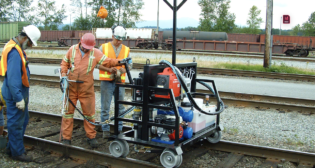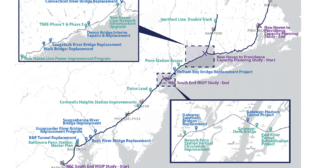
Fastening system solutions
Written by Mischa Wanek-Libman, Editor, Railway Track & Structures; and Engineering Editor, Railway AgeNo matter the environment, fastening systems need to be resilient, easy to install and customizable to a variety of specifications.
A well-designed fastening system not only preserves proper track geometry, but will also help to extend the life of other components. Suppliers of these systems are focused on improving the resiliency of fasteners used in freight operations, while fastening systems for passenger operations have been incorporating advanced materials to make the components lighter in weight and easier to transport.
Transit solutions
L.B. Foster Company says it utilizes its technical and product development expertise to introduce customized product solutions to meet specific customer needs. According to Jason Bowlin, General Manager, L.B. Foster Transit Products, “35 different fastening designs have been developed to meet the unique requirements of transit agencies across North America. We closely collaborate with engineering design firms and transit authorities to address critical requirements such as stiffness, adjustability, rail seat width and alternative clip designs.”
As examples: “Our design of a resilient tie system, incorporating a concrete tie/boot, elastomeric pad, insulator and clips, has recently been introduced into a West Coast transit system. To grow our position across North America, we continue to focus on evolving customer needs. And to enhance the performance of components in severe environmental conditions such as tunnels, through the novel use of coatings, solutions involving application to specific elements of the fastener are expected to dramatically reduce corrosion from stray currents and significantly extend the fastener life.”
More than nuts and bolts
Lewis Bolt & Nut Company introduced its patent pending Quick-Set® Hook Bolt System following successful testing at TTCI. The company says the new system is designed to be installed from the surface of a bridge deck and does not require holes to be drilled through the bridge ties.
The single Quick-Set bolt can be installed in under five minutes by sliding the hook bolt through the associated bracket, attaching the hex nut and engaging the flange. Installing high-strength lag screws through the bracket and into the ties, and adding a second (lock) nut, completes installation.
The Quick-Set system offers an option to include a built-in continuous guard rail along with a new bracket the company says offers a wider surface area that allows lags to be installed closer to the center of the bridge ties.
Lewis Bolt together with Nylok® Corp. recently developed the new Everlok™ Nut, which incorporates a patented, proprietary patch applied by Nylok. Once installed to recommended torque values, the nut remains tight. If desired, it can be removed and re-installed without damage to threads as is common on metal-to-metal lock nuts.
Improved product life
Pandrol North America uses a three-dimensional printer that allows the company to design, evaluate and review concepts with customers before a final design is produced. “This, along with having a small production line dedicated to R&D prototyping, reduces the lead time of turning an idea into a real product. However, we do understand a product is not complete until it passes the true test of performing in daily service under real operating conditions,” said Allen Goff, Vice President Sales and Marketing.
The FE1505 rail fastening assembly is an example of this. It was created in response to customer requests for a fastening assembly to last the life of rail in heavy-haul applications. The FE1505 is equipped with a recessed rail seat utilizing a FASTCLIP fastener and two-piece integral pad. It has been installed in a heavy-haul environment for more than two years and “continues to perform very well,” said Goff.
Pandrol has also implemented a second production line to meet the growing demand for its customizable Victor tie plates, which utilize standard AREMA rolled steel tie plates in customer-requested sizes equipped with the customer’s choice of resilient fastener. The Victor product line includes a “Rollblock” version that provides a solid flat bottom, eliminating the protrusion created by a bolt head. Pandrol has also taken its well-known ‘e’-clip design to another level. “The new ‘e’-clip RE offers all the familiar advantages of the original design but with fewer components that provides faster installation and improved product life,” said Goff.
Maintaining gauge
Progress Rail Services has integrated its latest acquisition under its Fastener Solutions Division, Rail Product Solutions (RPS), a provider of fastening systems freight and transit.
The latest product offering is GageLok® screws. The self-drilling GageLok secures rails and tie plates to traditional, wood ties, and can be used to replace traditional cut track spikes and screw spikes to prolong tie life and minimize tie splitting during insertion. According to Progress Rail Director of Fastening Engineering Jose Mediavilla, “The unique manufacturing technology allows GageLok screws to be formed cold. That results in a tougher, more shear resistant product that can stand up to the rigors of curved track in heavy-haul environments. The added shear strength and thread grip of our GageLok screws allow them to be used against the rail or as plate-holding screws to prevent gauge widening. Laboratory and field tests on Class I railroads have proven that our GageLok screws can hold track gauge up to three times longer than traditional methods.”
For concrete ties, gauge restraint is achieved with the ME63 “skl” style fastening system, which uses the inherent structural strength of concrete coupled with the advanced design and manufacturing process of the fastening components.
Optimized functionality
Vossloh Fastening Systems introduced a fastener for high speed and conventional slab track applications: System 300 NG (New Generation), described as “the evolutionary next step of our System 300, with design updates that optimize surface geometries and increase material efficiency, thereby reducing the overall volume of material needed to achieve the same performance and safety standards as System 300.”
“This improved usage not only saves the environment, but also reduces logistics costs. These new components are adapted to the already approved Vossloh Skl 15 tension clamp to ensure the established characteristics of System 300, e.g. high fatigue strength and high toe load. The highly elastic cellentic intermediate plate optimizes load distribution,” said Vossloh.
“Many of our systems utilize composite plastics components that are resistant to corrosion and abrasion, while also providing electrical insulation. Compared to steel, these lightweight materials also provide the added benefit of reduced logistics costs, as these lighter weight materials are much less expensive to transport to the job site. Examples include Vossloh fastening systems DFF 21 and DFF 300 UTS for urban transport. Both feature a durable nylon baseplate. Many of our systems include our patented cellentic rail pad, an elastomer made of EPDM that serves to increase stability, as well as reduce noise and vibration. Our W40 systems for heavy-haul utilize another type of innovative rail pad geometry that reduces rail tilting and deflection, increasing the life of the components,” said Vossloh.
High strength fastening systems
Alcoa Fastening Systems & Rings manufactures the Huck 360®, a locking fastener that the company says improves on the traditional HuckBolt® system by providing dependable clamping strength and reliability that HuckBolt® fasteners are known for, but with the added benefit of offering quick installation and removal with conventional tools. The Huck 360 eliminates the ‘gap’ around the crest of the bolt when tightened to a specific clamp force, preventing transverse vibration by locking the thread flanks in place. With conventional nut-and-bolt systems, clamp load quickly decays under vibration.



